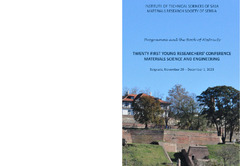| dc.description.abstract | Magnetic iron oxide nanomaterials, which enable a multitude of uses, are given special focus in the fields of biomedicine and environmental protection. The detection, sorption, and/or degradation of inorganic (lead, chromium, arsenic, and cadmium), organic (dyes, pharmaceuticals, pesticides, phenols, and benzene), and biological (viruses and bacteria) pollutants can all be effectively accomplished with the use of magnetic nanoparticles. Magnetic iron oxide nanomaterials are in particular focus for use as hyperthermia media in cancer treatment and as magnetic resonance imaging (MRI) contrast agents. The possibility of magnetic separation of such materials, due to their essential properties under the influence of an external magnetic field, reduces production costs and also prevents the production and accumulation of toxic waste. Among the many metal oxide nanomaterials, magnetite (Fe3O4) and maghemite (γ-Fe2O3) are currently the only two magnetic materials approved by the US Food and Drug Administration (FDA) for human use as iron deficiency therapeutics and as contrast agents for MRI. Here, we synthesized nanoparticles of magnetite (Fe3O4) by the method of reduction-precipitation and characterized. Additionally, potential binding of brilliant green dye on Fe3O4 and construction of innovative magnetic composite was investigated. The physicochemical features were explored using X-ray diffraction (XRD),
Fourier-transform infrared spectroscopy (FTIR), and field emission scanning electron microscopy (FESEM). XRD analysis confirms formation of the crystal phase of magnetite. The presence of magnetite nanoparticles is shown by typical groups for the peaks of iron compounds at a lower wavelength (≤ 700 cm-1) that are characteristic of the Fe-O bond. Morphological analyzes with FESEM showed that magnetite is a composite of nanospheres and nanorods that provide a large surface area. Dye binding study was performed using UV visible and FTIR spectrometer. | sr |

